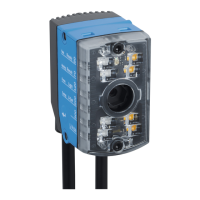6.5.5 Wiring the digital inputs
The device has two switching digital inputs (Sensor1, Sensor 2).
Functions (examples)
•
Start and end external reading cycle.
•
Feed in incremental signal.
Position of digital inputs
•
Male connector of the device cable (M12, 17-pin, A-coded)
•
Adapter cable (female connector, M12, 17-pin, A-coded/male connector, D-Sub-
HD, 15-pin)
•
Open end of the adapter cable (female connector, M12, 17-pin, A-coded/open
end)
All digital inputs are available at the individual positions.
Signal 3
52.3 K
3 K
"
§
$
Sensor GND
V
S
2
V
S
V
S
V
in
5
!
PNP sensor 1
GND
GND
Switching input of device 4
GND
V
S
Figure 21: Wiring a digital input
1
Trigger sensor (PNP sensor)
2
Supply voltage V
S
3
Input signal
4
Digital input of the device (Sensor 1, Sensor 2)
5
Input voltage V
in
! ...
$
Pin assignment (see respective device)
Table 9: Characteristic data of the digital inputs (Sensor 1, Sensor 2)
Switching behavior Signal on the input starts the assigned function, e.g. start of the
internal reading interval of the device.
Default: active high
Debouncing: 10ms (standard)
Properties
•
Opto-decoupled, reverse polarity protected
•
Can be wired to PNP output of a trigger sensor
Electrical values The electrical values are identical for all digital inputs of the
device.
Low: V
in
1)
≤2V; I
in
2)
≤0.3mA
High: 6V ≤V
in
≤27.6V; 0.7mA ≤I
in
≤5mA
1)
Input voltage V
in
.
2)
Input current I
in
.
Function assignment
NOTE
Allocate the functions for the digital inputs in the device using a configuration software,
e.g., SOPASET.
ELECTRICAL INSTALLATION 6
8024830/1MBT/2024-05-22 | SICK O P E R A T I N G I N S T R U C T I O N S | Lector61x
39
Subject to change without notice

